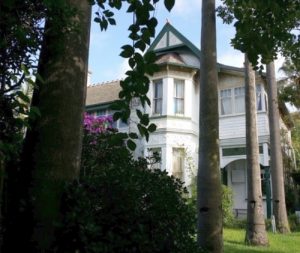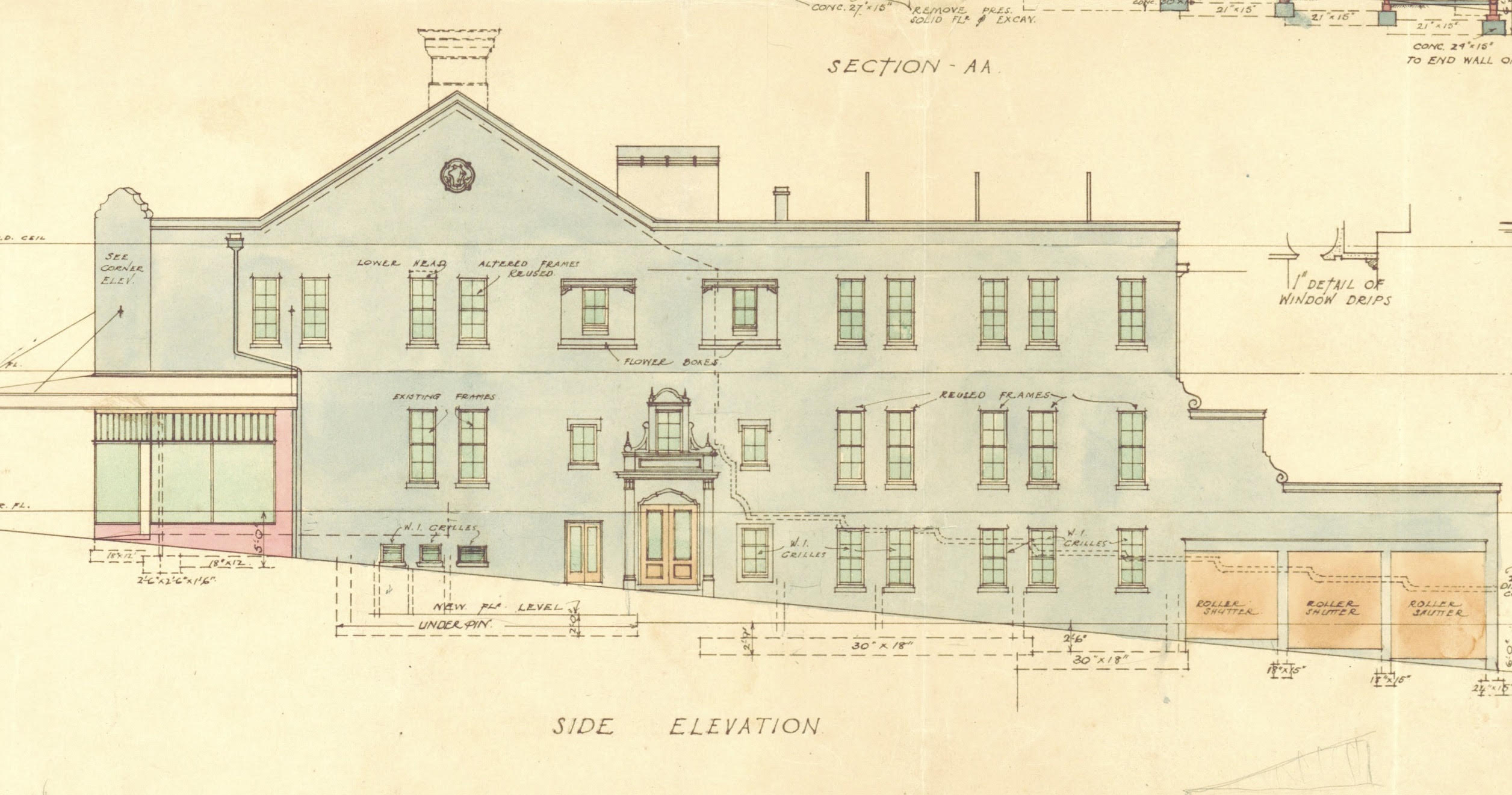
by Lyn Collingwood, October 2022, from Bulletin 8 of 2022
Land cornering Forsyth St and Glebe Rd, part of 36 acres granted to Captain William Dumaresq in 1840, was auctioned as the 15-allotment Avona Estate in March 1899.
James Stedman, a prosperous confectioner, bought four lots when prices were low because of economic depression and the taxation of speculators. Within months Stedman had engaged stonemasons and bricklayers to erect three villas for rental on the main road: Fairleigh and Milford, plus Holwood on the Forsyth St corner. As was customary, the buildings were known by name rather than street number.
James Stedman
James Stedman was born on Christmas Day 1840, the son of Henry Stedman, a convict transported as a 16-year-old for stealing clothing from his master. James was a boy when he began working for wholesale confectioner William Cates. In 1860, he married Margaret Noble and 15 years later went into the sweet-making business on his own while his wife ran the retail outlet. In 1891 the shop and factory moved from George St to Stedman’s Imperial Steam Confectionery Works in Clarence St. Here, a 50-strong workforce turned out five tons of sweets a week. Loyalty to the firm was strengthened by excursions, picnics and playing cricket against rival the lolly-makers, Biddell Brothers. In 1900, James Stedman Ltd was registered.

Stedman travelled to London to keep abreast of new machinery and marketing practices. His elaborate window displays featuring bonbons and fruit candles attracted customers, as did decorated rolling pins, mechanical toys and other novelty packaging. His biggest seller was his Lion Brand of toffee, butterscotch and caramels. Also popular were bull’s eyes, brandy balls and peppermints. Puddings and cakes were added at Christmas, and Stedman, as a director of the Society for Destitute Children at Randwick, arranged for each child in the Asylum to receive a card containing a sweet ‘hidden treasure’. Stedman was also treasurer of the Loyal Strangers’ Refuge Lodge, a director of Sydney Hospital and president of the Benevolent Society. Predeceased by his wife, he died in Hobart in 1913 after an operation for appendicitis. His body was transported to Waverley Cemetery and interred in the family vault.
The family patriarch was survived by six of his eight sons: James Noble (1861-1944), George Albert (1866-1941), William Joseph (1870-1961), Herman Archibald (1873-1935), Septimus (1875-1930) and Sydney Noble (1877-1969). All went into the confectionery business, and four are known to have moved to Glebe after their marriages at St Paul’s Redfern: James Jnr and Elizabeth Eleanor née Pullen; George and Helena Emilie née Buddee; William and May Elizabeth née Omant; Septimus and May Omant’s sister Daisy Earle.
Henry Stedman called his Surry Hills house Godalming (presumably after his birthplace in Surrey), and his grandson James Noble gave the same name to his home at 29 Avenue Rd. Almost next door was his brother William at No. 33. Septimus lived at Ilfracombe, 397 Glebe Rd, a few doors from George at Holwood No. 375 (his daughter Olga Elise died there as a toddler in 1910). Willed the house by his father, George continued to live there until 1915, when he moved to Neutral Bay. James moved to Artarmon. Septimus sold Ilfracombe in 1920 and moved into Godalming before settling in Manly.

James Noble, who succeeded his father as managing director of James Stedman Ltd, amalgamated that company with Henderson’s Lolly Factory to create James Stedman Henderson’s Sweets Ltd with himself as chairman. The factory moved from Haymarket to ‘Sweetacres’ at Rosebery where over a thousand workers, mostly female, produced huge amounts of confectionery, including the firm’s own patented Minties and Jaffas – plus Fantales made specifically for movie goers. When sugar was rationed during the Second World War, the idea was floated to switch to the manufacture of dried vegetables.
Stedman-Henderson was progressively taken over by Hoadleys, Rowntree and Nestlé. Today’s Sweetacres Park, Stedman St, Sweet St and Confectioners Way recall the now demolished Rosebery factory.
Gaetano Tesoriero
Holwood boasted hot water, a telephone and a tram stop at the front door when George Stedman moved with his family to Neutral Bay, and the building was rented out. It was run as Miss E Freestone’s boarding house for a couple of years, after which the internal spaces functioned as individual flats tenanted by electrical fitter Peter Schmidt (who changed his name to Smith in 1918), and others.
In August 1928, the Stedman family sold the building to Glebe fruiterer Gaetano Tesoriero and his wife Maria Francesca (known as Ciccina) née Giuffre. Earlier that year, Tesoriero had been severely burned when his truck’s tank exploded while he was filling it with petrol.
Gaetano Tesoriero was born in Panarea, Lipari Islands, in 1892 and migrated to Sydney in 1920. Although naturalised, he was interned at Orange and Hay during the Second World War. At that time, his assets included the Glebe flats and shop, his own home and a cottage at Randwick, and land at Granville. His wife, born on the island of Salina in 1895, died in August 1991, predeceased by Gaetano in November 1960. Both were interred in the family vault in Eastern Suburbs Memorial Park.
In May 1932 Council approved the conversion of 375 Glebe Point Rd to four flats and a shop. The architect was Henry Ebenezer Budden in partnership with Nicholas Mackey (the pair also designed Railway House in York St and the Water Board Building in Pitt St). The builder was J (probably Sicilian-born Joseph) Loschiavo. The original building was retained within a rendered Art Deco facade and new awnings. It was christened Diana Flats.
Allan Costin
The Tesorieros leased a flat and the newly-built shop to butcher Allan James Costin. Born at Moruya in 1895, Costin enlisted in the AIF in 1916, served as a gunner and driver in France and Belgium, and returned to Australia in 1919. In 1922 he married Sylvia Doris Fletcher.
The Costins did not stay long at no. 375. In May 1933, their son Keith was electrocuted when experimenting with wires on the roof. While ruling the death as accidental, the coroner labelled the area a death trap with live electric wiring and wet sheets blowing on the clotheslines. After being fined for selling minced meat adulterated with the preservative sulphur dioxide, Allan Costin moved with his wife to Crows Nest.

Within a decade, the Costins were back in Glebe, with Sylvia managing the mansion Hilston, 227 Bridge Rd, then divided into 12 flats. For years the landlady had a prickly relationship with one boarder, Hazel Ruby Husted, and tried to have her evicted, placing a notice in the bathroom: ‘If you don’t like this place, get out!’. The pair became well known in Glebe Court. Costin complained of noise: banging doors, high heels and a crying baby. Husted sued Costin for slander over accusations that she was an immoral woman and had stolen pennies from the gas meter. Husted claimed damages of £400 but was awarded a farthing. In 1954 Costin was fined £50 for charging more than fair rent for two of the residential’s rooms, but by 1961 she had saved enough to purchase Hilston from Finlay Elgin Munro’s daughter Lilian Ada Tain Munro of Darling Point. Sylvia Costin died in 1980, predeceased by her husband, a war pensioner, in 1969. They were buried at Macquarie Park, the resting place of their son Keith.
Evidence remains at 375 Glebe Point Rd of its past use as a butchery. Lessees of the shop after the departure of Allan Costin include Alexander Watson Smith, Albert Clement Wilson, William Henry Philippe and Charles Coventry. The story of Hilston, 227 Bridge Rd, is told in an article on other Glebe butchers, the York brothers, published in the April 2017 Bulletin.
Sources: Archives Hub; Australian Dictionary of Biography James Stedman entry; National Archives of Australia; NSW cemetery records; NSW electoral rolls; NSW Land Registry Services; NSW registry of births, deaths, marriages; NSW State Archives & Records; pocketoz.com.au website; Rathbone, Ron A Very Present Help; Sands Directories; Trove website.
 Architect’s plans for shop and Diana Flats, 1932 (Image: Tim Smith)
Architect’s plans for shop and Diana Flats, 1932 (Image: Tim Smith)









There are no comments yet. Please leave yours.